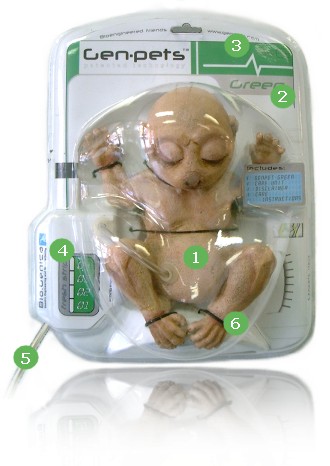The world of bioart recently facilitated by advancements in biotechnology has created both a new medium to express art and a new platform in which artists can comment on science and its practices. Just as new frontiers of technology which manipulate living organisms, Bioart is often subject to scrutiny from the public eye due to debates of its ethics.
Bioart has has increased the avenues with which art can be explored. At first, I did not really understand the difference between what scientists and artists were utilizing biotechnology for. It just seemed to me that artists were using this technology in a somewhat frivolous way; however, after doing some research, I know realize that bioart is just another way artists are pushing the envelope of expression. It also acts as another bridge that can connect the worlds of art and science given that artists have to have a background in science to produce this form of art. An example of bioart can be seen in Hunter O’Reilly’s Living Drawings which use glowing bacteria to produce an image.
http://www.huntercole.org/artgallery/livingbacterialdrawings/images/plantembryo1m.JPG
Adam Brandej’s Genpets collection showcase a small creature in a package which resembles a toy. The creature is made out of latex and is strapped to a heart monitor. It’s limbs are bound, and the wrists and ankles are slightly inflamed to show the animal has been struggling against the restraints. There is a website connected with the Genpets display that makes it seem like genetically engineered pets are available for purchase. This showcase offers commentary on the consequences of biotechnology and genetic engineering.
Adam Brandej’s Genpets collection showcase a small creature in a package which resembles a toy. The creature is made out of latex and is strapped to a heart monitor. It’s limbs are bound, and the wrists and ankles are slightly inflamed to show the animal has been struggling against the restraints. There is a website connected with the Genpets display that makes it seem like genetically engineered pets are available for purchase. This showcase offers commentary on the consequences of biotechnology and genetic engineering.
http://www.genpets.com/images/Genpet_feature.jpg
Although people seem hesitant to the possibilities of biotechnology, many examples can be seen in our own popular culture. For instance, the popular Marvel superhero, Spider-Man, receives his powers through genetic mutation from a spider bite. With the social acceptance of fictional characters like Spider-Man, it leads me to believe that studies and research will continue to make strides in the biotechnology field.
Although people seem hesitant to the possibilities of biotechnology, many examples can be seen in our own popular culture. For instance, the popular Marvel superhero, Spider-Man, receives his powers through genetic mutation from a spider bite. With the social acceptance of fictional characters like Spider-Man, it leads me to believe that studies and research will continue to make strides in the biotechnology field.
Works Cited:
DaSilva, Edgar. "Art, Biotechnology and the Culture of Peace." Electronic Journal of Biotechnology. N.p., 15 Aug. 2004. Web. 10 Nov. 2013. <http://www.ejbiotechnology.info/content/vol7/issue2/full/8/>.
Gkoutziouli, Katerina. "Art and Biotechnology: When Art Looks into Science |." The Rest Is Art. N.p., 26 Oct. 2010. Web. 10 Nov. 2013. <http://therestisart.wordpress.com/2010/10/26/art-and-biotechnology-when-art-looks-into-science/>.
"Spider-Man." Wikipedia. Wikimedia Foundation, 10 Nov. 2013. Web. 10 Nov. 2013. <http://en.wikipedia.org/wiki/Spider-Man>.
Vesna, Victoria, narr. “BioTech Art Lectures I-V.” N.p., . web. 5 Nov 2012.
Weir, Kirsten. "Biotechnology on Display." The Scientist. N.p., 9 Mar. 2007. Web. 10 Nov. 2013. <http://www.the-scientist.com/?articles.view/articleNo/24834/title/Biotechnology-on-display/>.



Hi Alyssa,
ReplyDeleteI was interested in your choices of example of bio-art. We are definitely coming upon a new age where biotechnology is slowly becoming the norm. I have never heard of Genpets, though it brings up a good point of some of the consequences of genetic engineering. I also forget to consider how superheroes are examples of biotechnology. As writers continue to create new heroes are ordinary men but through science attain super powers, scientists will strive to make this a reality.
Best,
-Katherine